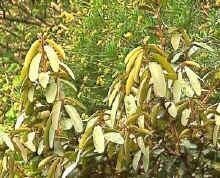Admire these strong indigenous plants as you walk over the rough terrain of the Magaliesberg. Taste their small fruits, if you are lucky enough to get there before the baboons eat them. Touch their dark tough leaves and feel the ripe tender fruits.
 |
|
Latin name
|
Englerophytum magalismontanum meaning that it was first identified in the Magaliesberg
|
|
Common name
|
Stamvrug or milk plum
|
|
Location
|
Throughout the Northern Province, Gauteng and North Western Natal in rocky areas. It grows on quartzite and granite soils.
|
|
Description
|
Low branching, multi-stemmed tree or shrub.
Leaves form rosettes of blue-green single, alternative leaves with conspicuous young golden brown leaves at tips of rosettes. The leaves are covered with a transparent waxy bloom that can be rubbed off.
Flowers in June to December are born directly on old brown stems. The small, creamy yellow masses of flowers and are strongly scented.
The fruit is ripen from December to February and is carried in bunches on the stem having been formed from the flowers. The fruit is 2cm long and bright red when ripe.
|
|
Edible
|
Definitely! You may even have to fight off the baboons and other hikers to get a taste. Rich in vitamin C, the fruit is tart but delicious with sticky, milky juice. The pip is rather large for the size of the fruit.
If you are not sure it?’s the right tree, please ask someone before tasting the wrong fruit.
Makes great jelly as well as wine, brandy and syrup
|
|
Medicinal
|
Reportedly some portion is good for epilepsy and rheumatism.
Headache remedy: cut your forehead and rub in some powered root while inhaling smoke from a fire made from roots.
|
|
Garden uses
|
Attractive, hardy shrub but needs the right soil.
|